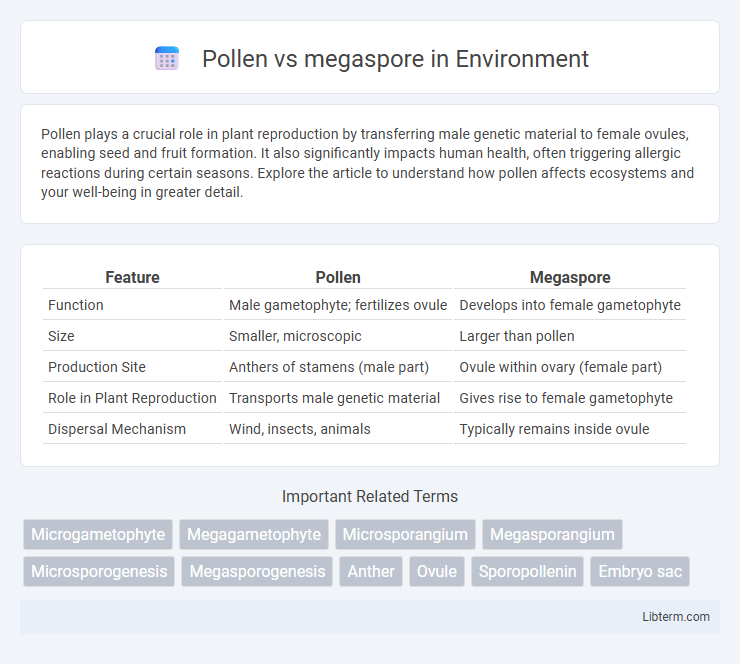Pollen plays a crucial role in plant reproduction by transferring male genetic material to female ovules, enabling seed and fruit formation. It also significantly impacts human health, often triggering allergic reactions during certain seasons. Explore the article to understand how pollen affects ecosystems and your well-being in greater detail.
Table of Comparison
| Feature | Pollen | Megaspore |
|---|---|---|
| Function | Male gametophyte; fertilizes ovule | Develops into female gametophyte |
| Size | Smaller, microscopic | Larger than pollen |
| Production Site | Anthers of stamens (male part) | Ovule within ovary (female part) |
| Role in Plant Reproduction | Transports male genetic material | Gives rise to female gametophyte |
| Dispersal Mechanism | Wind, insects, animals | Typically remains inside ovule |
Introduction to Plant Reproduction
Pollen grains are the male gametophytes in seed plants responsible for delivering sperm cells to the ovule, while megaspores develop into female gametophytes within the ovule. Pollen enables fertilization through wind or animal pollination, facilitating genetic diversity and seed formation. Megaspores undergo mitosis to form the embryo sac, which houses the egg cell for fertilization and subsequent embryo development.
What Are Pollen Grains?
Pollen grains are the male gametophytes produced by seed plants, responsible for transferring sperm cells to the female ovule during fertilization. Unlike megaspores, which develop into female gametophytes, pollen grains contain multiple cells including a generative cell that divides to form sperm cells. These microscopic structures have a protective outer layer called the exine, allowing them to survive harsh environmental conditions while facilitating pollination.
Understanding Megaspores
Megaspores are haploid spores produced by the megasporangium during the process of megasporogenesis in seed plants, serving as the precursor to the female gametophyte. Unlike pollen, which is the male gametophyte responsible for fertilization, megaspores undergo mitotic divisions to develop into the embryo sac within the ovule. Understanding megaspores highlights their crucial role in sexual reproduction and seed formation by giving rise to the structures that generate egg cells for fertilization.
Origin and Development of Pollen
Pollen originates from microspores produced in the microsporangia of the anthers in seed plants, developing through meiosis of microsporocytes. Each microspore undergoes mitotic divisions to form a mature pollen grain containing male gametophytes essential for fertilization. This development process contrasts with megaspores, which arise from megasporocytes in the ovule and give rise to female gametophytes.
Formation and Function of Megaspores
Megaspores are formed through meiosis within the ovules of seed plants, specifically inside the megasporangium, where one diploid megasporocyte divides to produce four haploid megaspores, usually with only one surviving. These haploid megaspores develop into the female gametophyte, or embryo sac, which contains the egg cell necessary for fertilization. In contrast, pollen grains, derived from microspores, serve as the male gametophytes responsible for delivering sperm cells to the ovule.
Structural Differences: Pollen vs Megaspore
Pollen grains are typically multicellular structures composed of a tough outer exine layer that protects the male gametophyte, facilitating dispersal to the female ovule. Megaspores are usually single-celled and larger, developing within the ovule to give rise to the female gametophyte, characterized by a thin, less robust wall suitable for nurturing embryo sac formation. The structural complexity of pollen contrasts with the simpler, nutrient-rich design of megaspores, reflecting their distinct roles in plant reproduction.
Role in Plant Fertilization
Pollen serves as the male gametophyte carrying sperm cells necessary for fertilization in seed plants, enabling the transfer from the anther to the ovule. The megaspore develops into the female gametophyte within the ovule, producing the egg cell for fertilization. Together, pollen and megaspore facilitate sexual reproduction by enabling sperm delivery and egg formation, respectively, ensuring genetic diversity and successful seed formation.
Pollen vs Megaspore: Genetic Composition
Pollen grains contain two haploid cells derived from meiosis and mitosis, with a unique genetic composition that facilitates male gamete delivery in seed plants. Megaspores are haploid cells formed by meiosis in the ovule, giving rise to the female gametophyte with a distinct genetic profile essential for fertilization. The genetic variation between pollen and megaspore reflects their complementary roles in sexual reproduction, ensuring genetic diversity in offspring.
Evolutionary Significance
Pollen and megaspores represent crucial evolutionary innovations in plant reproduction, with pollen enabling the transfer of male gametes through air or animal vectors, enhancing fertilization efficiency in diverse environments. Megaspores develop into female gametophytes within protected ovules, facilitating internal fertilization and the evolution of seed plants. These adaptations reduced dependence on water for reproduction, contributing to the widespread colonization of terrestrial habitats by gymnosperms and angiosperms.
Key Differences and Summary
Pollen grains are male gametophytes in seed plants responsible for delivering sperm cells to the ovule, while megaspores develop into female gametophytes that produce eggs. Pollen is typically microspore-derived and adapted for dispersal via wind, insects, or other agents, whereas megaspores remain within the ovule and undergo mitosis to form the embryo sac. The key difference lies in their roles in reproduction: pollen facilitates fertilization by transporting male genetic material, whereas megaspores give rise to the female gametophytes essential for seed formation.
Pollen Infographic

 libterm.com
libterm.com